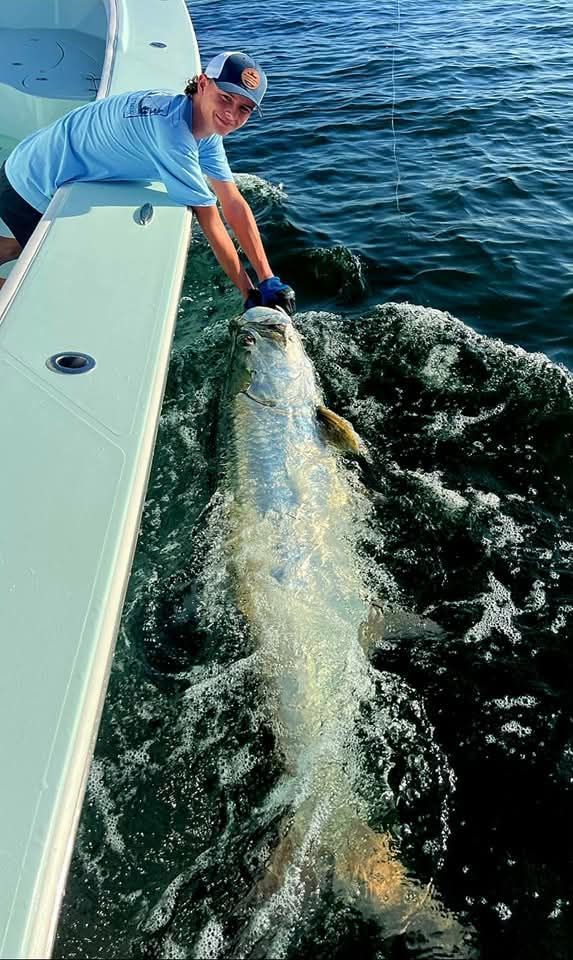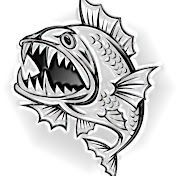Tarpon Fishing
Tarpon (Megalops atlanticus), often called the "Silver King," are one of Florida's most iconic inshore game fish due to their incredible fighting ability and impressive size. These majestic fish have a sleek, silver body and large, reflective scales, making them easily recognizable. The name "tarpon" comes from the word "tarpum," which is derived from a local Caribbean language.
An interesting fact about Tarpon is that they have a unique ability to breathe air. Unlike most fish, Tarpon possess a specialized swim bladder that functions like a lung, allowing them to gulp air at the surface. This adaptation enables them to survive in oxygen-poor waters where other fish might struggle. This fascinating trait, combined with their impressive size and leaping ability, makes Tarpon one of the most unique and exciting game fish in the world.

How big do Tarpon get?
Tarpon are one of the largest game fish found in Florida waters. They can grow up to 8 feet in length and weigh as much as 280 pounds. The average size of Tarpon typically caught ranges between 60 to 100 pounds, but it is not uncommon for anglers to hook much larger specimens, particularly during peak season. Their impressive size and acrobatic fights make them a prized catch for sport fishermen. The all-tackle world record (additionally certified as the 80-pound class record) for a giant tarpon is 286-pounds, 9-ounces caught by Max Domecq in Rubane, Guinea-Bissau, Africa on March 20, 2003.
How fast do Tarpon grow?
Tarpon grow relatively quickly in their early years. Juvenile Tarpon can reach lengths of about 30 inches within their first year. Growth rates slow as they age, but they continue to increase in size throughout their lives. By the time they are 10 years old, many Tarpon are over 6 feet long. Their growth rates can vary depending on factors such as food availability and environmental conditions.
What months are the best for Tarpon Fishing?
The best months for Tarpon fishing in Florida are from May through July. During this period, the waters are warm, and large schools of Tarpon migrate along the coast, providing excellent fishing opportunities. Early morning and late afternoon are typically the most productive times to fish for Tarpon. However, some resident Tarpon can be found year-round, especially in areas with warm water outflows such as power plants.
How long do Tarpon live?
Tarpon are long-lived fish, with some individuals living up to 50 years. The average lifespan of Tarpon in the wild is around 30 years. Their longevity, combined with their late maturity, makes them particularly vulnerable to overfishing, which is why catch and release practices are strongly encouraged. Proper handling during release is crucial to ensure the survival and continued health of these magnificent fish.
What are the best baits for Tarpon fishing?
The best baits for Tarpon fishing include live bait such as crabs, shrimp, and mullet. Live bait tends to be the most effective, especially when fished near the surface where Tarpon are often found feeding. Artificial lures like soft plastics, swimbaits, and topwater plugs can also be effective, especially when mimicking the natural prey of Tarpon. The choice of bait can depend on the specific conditions and the behavior of the fish on any given day.
How long do Tarpon live?
The best places to fish for Tarpon are along beaches, in passes, and around bridges. Coastal areas with warm, shallow waters provide ideal environments. Popular spots include Boca Grande Pass, known as the "Tarpon Capital of the World," the inlets around Fort Myers, and Tampa Bay. These areas are prime locations where Tarpon come to feed on schooling baitfish, offering anglers the best chance of hooking these powerful fish.
Does Badfish do Tarpon Fishing Charters?
Yes, we run Tarpon charters out of
Anna Maria,
Bradenton,
Palmetto,
Ruskin,
Tampa,
Sarasota, which are all located near
Siesta Key. Typically between the months of May to July which are the best months to target these awesome fish. Give us a call today to book your next fishing charter and let's talk whats biting.


